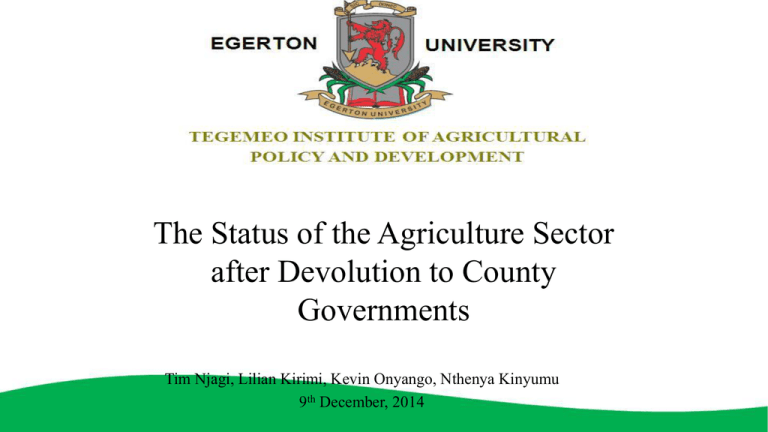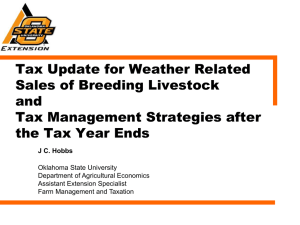DEVOLUTION - Tegemeo Institute
advertisement

The Status of the Agriculture Sector after Devolution to County Governments Tim Njagi, Lilian Kirimi, Kevin Onyango, Nthenya Kinyumu 9th December, 2014 Importance of Ag Sector 8 6 4 2 0 2000 2001 2002 2003 2004 2005 2006 2007 2008 2009 2010 2011 2012 -2 -4 -6 National GDP Agriculture GDP 2 Ag Sector Contribution to Household Income 100 90 80 70 60 50 40 30 20 10 0 3 Introduction…/3 • Sector performance is key to food security, poverty reduction, improving living standards and national economic performance • Strong sector growth only possible if county governments register strong performance in the sector 4 Motivation • To achieve the ambitious targets and stimulate growth in the sector: – Both National and County governments need to work seamlessly and complementarily • Need for stock-taking after one year in the devolved system to: – Understand how the sector is adjusting after devolving majority of function to county govts – Establish good practices by County governments – Identify constraints/challenges and propose remedial actions – Identify strategies to strengthen the performance of the sector at the counties 5 Study Objectives • Determine the organizational structure of the Ag sector after devolution • Identify policy communication channels – Between national and county – Between County govt & stakeholders in the county • Define the planning process at the county, linkages to national plans, coordination & implementation of programs & projects • Assess the level of financing for the sector • Establish challenges experienced, best practices and lessons learnt 6 Methodology • 16 counties purposively selected for the study in 4 regions Western Rift Valley Central Eastern Siaya Trans Nzoia Nyandarua Makueni Kisumu Uasin Gishu Nyeri Machakos Kisii Bomet Kirinyaga Migori Narok Vihiga Nakuru Kakamega • Face to face key informant interviews with Ministry officials: • CECs • Chief Officers • County Directors • A structured checklist used to obtain qualitative and quantitative data 7 Transition to County Govts 8 Transition Process Legal Provisions • The constitution provides for a phased transfer of powers – in a period of <3 years from the date of the first elections under the constitution • The National government shall facilitate the transfer of power by: – Building the capacity of county governments – Establishing the criteria that must be met before particular functions are devolved to county governments – Permit the asymmetrical devolution of powers Reality • First elections were conducted in March 2013 – After taking office, county governments have been establishing the requisite departments • Due to political reasons, from 1st July 2013, county governments took over the majority of the functions listed in the fourth schedule, among them all the listed functions in the agricultural sector. 9 Organization of the sector 10 What changed - overall National Government (Executive) Ministries, Departments and Agencies Summit Intergovernmental Relations Technical Committee Council of Governors County Governments County Departments Sub County Ward Communities 11 What changed - Ag sector Centralized system Devolved system • Two main but connected levels • Two distinct levels – Ministry HQ – Decentralized level • Tiers (Province, District, Division) • Focus on District level – Clear reporting channel from Location all the way to HQ – HQ has authority over activities at decentralized levels – National – County • Tier (sub county and ward levels) – National govt staff at county moved to county govts – No clear feedback mechanism between National and County govts Currently, organization structure remains largely the same as before devolution, with a few notable exceptions e.g. CS, PS, CECs, COs, CDAs Reforms taking place at the national level 12 Ag Sector Reforms • Reforms in the Ag sector aimed at increasing efficiency, service delivery & standardization • Key laws enacted include AFFA Act, 2013 & Crops Act, 2013 • Affect how ag sector is managed – Overlapping mandates between national & county governments e.g. extension services & farm input subsidies 13 Human Resources • No structured handover of human resources from NG to CGs • Several challenges – Low staff levels at sub county and ward levels • Most critical- livestock, fisheries, coop development – Low staff morale due to uncertainties • scheme of service, welfare issues (promotion, transfer) • a lack of facilitation in the most part of the FY – Political environment considered unfavourable • Recruitment process different btw NG & CG – Mismatch between skills and roles 14 Communication 15 Communication Channel../1 Channel before devolution MoA PDA DAO DivAEO • Modes used included letters, circulars, telephone and e-mails • Food security reports were done monthly, other reports done annually, half-yearly (subject matter reports) • Communication was more frequent – several times in a week • Reverse communication followed the same channel 16 Communication Channel../2 Channel after devolution Ministry of Agriculture Ministry of Devolution Council of Governors County Governor C.E.C Chief Officer Director Action Section • Most communication from NG is still sent through circulars, letters and e-mails • Communication from Counties include monthly food situation reports and specific section reports done on need basis/on request • The reverse communication is supposed to follow same channel – In most cases this does not happen, instead we have: • SCAO-CDA- HQ, or • SCAO-CDA-Chief Officer- HQ 17 Communication channel../3 • The channel is long and results into – Untimely arrival of information & failure to reach the action points – Distortion of information – Wastages in information verification process (resources and time) – Enhanced mistrust between officials in the channel • The MoALF deployed liaison officers to link up with counties – Strong opposition from counties resulted in their rejection – Those still at the county perform other roles • Information exchange has reduced significantly 18 Planning & Implementation of Programs 19 Planning & Coordination before devolution../1 • Agriculture sector had several line ministries including Agriculture, Livestock Development, Fisheries, Cooperatives Development • There were 2 levels of planning: national and district • At the national level, planning was coordinated by the Agriculture and rural development sector – The sector mechanisms coordinated identification of priorities and funding • The ministries of Ag, Livestock & Fisheries formed ASCU which was to spearhead the coordination of Ag sector 20 Planning & Coordination before devolution../2 • At the decentralised levels, projects and programs were identified, planned and implemented through: – District Development Committee (DDC) – District Executive Committee (DEC) – Sub-district Development Committee (Sub-DDC) – Location Development Committee • Major challenge was a mismatch between planning & budgeting – Priorities identified at the national level were more often different from what districts identified as priorities 21 Planning & Coordination after devolution../1 • Most counties have finalized their CIDPs – MoDP gave guidelines to develop CIDP – CIDP be in line with the Vision 2030, MTP 2, and Sector Plans – Public participation a constitutional requirement • Most counties put more emphasis on public participation and Governors’ manifestos – Involvement of technical experts limited – Prioritization of development needs? – Quality of public participation? – Sustainability of CIDPs?? • Final approval of CIDPs by County Assembly – Viability? 22 Planning & Coordination after devolution../2 • Plans captured in CIDPs for many counties include: Farm input subsidy program Soil sampling and analysis Promotion of horticultural crops (Bananas, Passion fruit, Potatoes, etc) Value addition (Milk coolers, Fruit processors, Mills etc) Farm Mechanization Promotion of Poultry, Apiculture and Fish farming following ESP model Revival and expansion of Animal health services Investment in Irrigation, Drainage and Water harvesting Revival and strengthening of farmer cooperatives and other Agricultural institutions Eg ATCs 23 National Government programs in counties • • • • • • • • • ASDSP (2022) - GoK NMK (2015) – GoK KAPAP (2014) – World Bank EAPP (2017) – World Bank – Dairy & Several value chains SHEPUP (2015) – Jica/GoK – Horticultural production and marketing SHOMAP (2015) – IFAD – Horticulture, Markets, Storage facilities SHDP (2015) – IFAD – Dairy production and value addition ALPRO – 2015 – Livestock production General fertilizer subsidy 24 Programs inherited by Counties • • • • • • • • Maize grain drying services NAAIAP - Renamed to Farm Input Support (FIS) AI services provision Agricultural mechanization Water harvesting and storage Stocking and restocking of fish ponds Extension and training ATCs, AMCs and ATDCs 25 Programs initiated by counties • Farm input subsidy program (independent in some counties, collaborative effort with NG in others) • Horticultural crop development and promotion • Farm mechanization – free tractor service program • Value addition for livestock & livestock products • Pyrethrum development and promotion program (collaboration with NG) • Agricultural land development – conservation & reclamation • Traditional high value crop development and marketing 26 Legislation 27 Bills for Ag sector at County Level • Most counties have not passed any bills relating to the sector – Only 6 Ag sector related bills in the counties were being processed • • • • • • County agricultural mechanization structure bill – Kirinyaga Potato packaging bill – Nakuru Agricultural boards and committees bill – Kisii Revolving fund bill – Siaya Animal health and disease control bill – Uasin Gishu Input subsidy and supply bill – Trans Nzoia • Serious lack of capacity to formulate and draft legislation/bills – At Dept level and County Assembly • Yet bills are needed to operationalize certain sector functions 28 Ag sector reforms • The Crops Act, 2013 establishes a crop development & promotion authority – Potential conflict with county mandate for promotion & development 29 Farmer Perceptions 30 AGRICULTURAL SECTOR FUNDING BY COUNTY GOVERNMENTS • Key concerns – Adequacy of funding to the sector • Counties may allocate a big % to non-core expenditure • Prioritization among different sectors – Expectations from the electorate, Governors Manifestos – Implication on implementation of sector activities 32 Budget and Flow of Funds 33 Before Devolution • Level of funding for ministries (recurrent and devt) determined by the ARD sector • District level funding through AIEs to DAOs, DLPOs, DFOs • Division level offices operated on imprests from the District • Flow of funds was quarterly or depending on project agreement e.g. half yearly • Challenges included late receipts of AIEs, unfinanced AIEs 34 Trends in Ag Sector Funding (National) Expenditure KES Millions 60,000 55,000 50,000 45,000 40,000 35,000 30,000 25,000 20,000 15,000 10,000 35 Share of Ag sector allocation in total budget 6.0 5.5 5.4 5.6 5.0 4.8 4.5 4.0 3.5 3.0 2.7 2.5 2.3 2.0 2009/10 2010/11 2011/12 2012/13 2013/14 36 Agriculture Budget Allocation 80 70 60 50 40 30 20 2002/2003 2003/2004 2004/2005 2005/2006 2006/2007 2007/2008 2008/2009 2009/2010 2010/2011 2011/2012 Devt Recurrent 37 Funding after devolution……../1 • Over 90% of funds from National government, the rest are donor funds for specific projects (mainly national govt projects) • Program based budgeting system adopted by many counties • Budgets approved by County Assembly & COB • Budget ceilings set for different depts • Recurrent funds transferred on monthly basis 38 Funding after devolution……../2 • Development funds transferred on reimbursement basis • Sub-counties are funded through AIE system in some counties • Generally, there is increased funding to the sector compared to prior system • However, not adequate given the functions and expectations/promises 39 Share of NG allocation in Total County Revenue (2013/14 FY) 1.0 0.9 0.8 0.7 0.6 0.5 0.4 0.3 0.2 0.1 40 Development Expenditure as a % of Total Expenditure (2013/14 FY) 0.9 0.8 0.7 0.6 0.5 0.4 0.3 0.2 41 Development Expenditure as a % of Total Expenditure for selected sectors (2013/14 FY) 60 50 40 30 20 10 0 Agr dev budget as % total expenditure Infrastr.dev budget as % total expenditure Trade dev.as % of total expenditure 42 Ag development budget as % development budget (2013/14 FY) 0.3 0.2 0.2 0.1 0.1 0.0 43 100% Ag Budget for selected Counties (2013/14 FY) 90% 80% 70% 60% 50% 40% 30% 20% 10% 0% Recurrent Development 44 Summary and Conclusions 45 Conclusions../1 1. Long and bureaucratic communication channel is a serious hurdle in information flow 2. There is increased funding to Ag sector although share of budget is still relatively low 3. Counties heavily dependent on funds from National government 4. Most spending in last quarter of FY, similar to before devolution 5. Weak planning & budget making process – Political manipulation 46 Conclusions../2 6. Lack of capacity to formulate and draft legislation/bills 7. Slow implementation of programs (lack of operationalizing policies) 8. Coordination failure – Between county governments • Programs, shared resources, alignment of goals – Between national and county governments • Duplication of projects e.g. soil testing, fertilizer subsidies, – Within the county • With other development stakeholders – Implications • Missed opportunities by CGs to create impact • Failure to exploit synergies 47 Conclusions../3 10.Serious staff shortage especially in directorates of Livestock, Veterinary, Fisheries and Cooperatives – S/county and wards 11.Low staff morale at county, sub-county and ward levels – Lack of offices and office facilities – Lack of transport (facilities or facilitation) – Lack of clear guidelines for staff recruitment, scheme of service • Staff previously under national govt have their salaries paid by counties but scheme of service is at national level 48 Conclusion../4 • Despite the challenges, there is reason for optimism –Based on good practices in some counties • Counties have complemented NG programs • Picked up projects that were implemented by NG • Drafting of bills 49 Recommendations • Need to increase funding to the sector • Strengthen planning & budgeting processes – Technical input important in planning process – Make use of available data • Address HR challenges – Harmonize recruitment at counties to be inline with PSC • Operationalize mechanisms to improve coordination between NG and CGs and among CGs e.g. IGTRC • Harmonize legislation to remove overlaps • Build capacity in county governments to effectively discharge their functions 50 Thank You! Acknowledgement This study is made possible by the generous support of the American people through the United States Agency for International Development (USAID). The contents are the responsibility of Tegemeo Institute and do not necessarily reflect the views of USAID or the United States Government.









